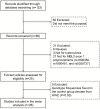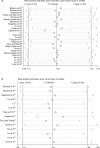Genetic polymorphisms of exon 1 of MBL2 contribute to tuberculosis risk especially in Asian populations: an updated meta-analysis of 26 studies
- PMID: 30154670
- PMCID: PMC6108403
- DOI: 10.2147/IDR.S168465
Genetic polymorphisms of exon 1 of MBL2 contribute to tuberculosis risk especially in Asian populations: an updated meta-analysis of 26 studies
Abstract
Background: Evidence suggests that genetic variations of exon 1 of mannose-binding lectin 2 (MBL2) may contribute to tuberculosis (TB) risk. Many studies have investigated the association between MBL2 exon 1 polymorphisms (rs1800450, rs1800451, and rs5030737) and TB risk, but yielded inconclusive results.
Method: We conducted this meta-analysis of 26 eligible case-control studies that included 7952 cases and 9328 controls to identify the strength of association. Odds ratio (OR) and 95% CI were used to evaluate the strength of association. Statistical analyses were performed by using STATA 12.1.
Results: We found a statistically significant correlation between MBL2 exon 1 polymorphisms and increased TB risk among three models: allele model (O vs A: OR =1.18, 95% CI: 1.01-1.38, Pheterogeneity<0.0001, I2=85.8%), homozygote comparison (OO vs AA: OR =1.49, 95%CI: 1.02-2.18, Pheterogeneity<0.0001, I2=79.1%), dominant model (AO/OO vs AA: OR =1.20, 95% CI: 1.01-1.43, Pheterogeneity<0.0001, I2=83.5%), especially in studies based on Asian populations among five models: allele model (O vs A: OR =1.29, 95% CI: 1.11-1.51, Pheterogeneity<0.0001, I2=66.0%), homozygote comparison (OO vs AA: OR =1.67, 95% CI: 1.09-2.55, Pheterogeneity=0.008, I2=54.2%), heterozygote comparison (AO vs AA: OR =1.26, 95% CI: 1.05-1.50, Pheterogeneity=0.001, I2=62.9%), dominant model (AO/OO vs. AA: OR =1.31, 95% CI: 1.10-1.56, Pheterogeneity=0.001, I2=64.2%), and recessive model (OO vs AO/AA: OR =1.50, 95% CI: 1.01-2.22, Pheterogeneity=0.023, I2=48.0%). Meta-regression results revealed that source of controls (p=0.009), but not ethnicity (p=0.687), genotyping method (p=0.231), and sample size (p=0.451) contributed to the source of heterogeneity.
Conclusion: This meta-analysis suggests that MBL2 exon 1 polymorphisms may contribute to TB risk, especially in Asian populations.
Keywords: MBL2; polymorphisms; rs1800450; rs1800451; rs5030737; tuberculosis.
Conflict of interest statement
Disclosure The authors report no conflicts of interest in this work.
Figures




Similar articles
-
A Meta-analysis of MBL2 Polymorphisms and Tuberculosis Risk.Sci Rep. 2016 Nov 23;6:35728. doi: 10.1038/srep35728. Sci Rep. 2016. PMID: 27876780 Free PMC article. Review.
-
Genetic polymorphisms of MBL2 and tuberculosis susceptibility: a meta-analysis of 22 case-control studies.Arch Med Sci. 2018 Oct;14(6):1212-1232. doi: 10.5114/aoms.2017.65319. Epub 2017 Jan 20. Arch Med Sci. 2018. PMID: 30393476 Free PMC article. Review.
-
Association of MBL2 gene polymorphisms with pulmonary tuberculosis susceptibility: trial sequence meta-analysis as evidence.Infect Drug Resist. 2019 Jan 11;12:185-210. doi: 10.2147/IDR.S188980. eCollection 2019. Infect Drug Resist. 2019. PMID: 30666135 Free PMC article.
-
Association of MBL2 exon1 polymorphisms with high-risk human papillomavirus infection and cervical cancers: a meta-analysis.Arch Gynecol Obstet. 2016 Nov;294(6):1109-1116. doi: 10.1007/s00404-016-4201-z. Epub 2016 Sep 13. Arch Gynecol Obstet. 2016. PMID: 27619685 Review.
-
Increased cancer risk associated with the -607C/A polymorphism in interleukin-18 gene promoter: an updated meta-analysis including 12,502 subjects.J BUON. 2015 May-Jun;20(3):902-17. J BUON. 2015. PMID: 26214646 Review.
Cited by
-
The Influence of the Lectin Pathway of Complement Activation on Infections of the Respiratory System.Front Immunol. 2020 Oct 21;11:585243. doi: 10.3389/fimmu.2020.585243. eCollection 2020. Front Immunol. 2020. PMID: 33193407 Free PMC article. Review.
References
-
- Ducati RG, Ruffino-Netto A, Basso LA, Santos DS. The resumption of consumption – a review on tuberculosis. Mem Inst Oswaldo Cruz. 2006;101(7):697–714. - PubMed
-
- Dorhoi A, Reece ST, Kaufmann SH. For better or for worse: the immune response against Mycobacterium tuberculosis balances pathology and protection. Immunol Rev. 2011;240(1):235–251. - PubMed
-
- Heitzeneder S, Seidel M, Forster-Waldl E, Heitger A. Mannan-binding lectin deficiency – good news, bad news, doesn’t matter? Clin Immunol. 2012;143(1):22–38. - PubMed
LinkOut - more resources
Full Text Sources
Other Literature Sources
Miscellaneous

